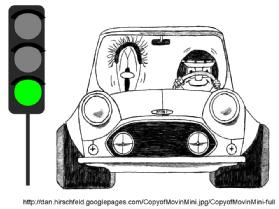3rd Year Projects 2010/11
Individual Differences in Automatic and Voluntary Control
It is well known that there are huge individual differences in people’s high-level, voluntary cognitive control faculties (e.g., in the ability to voluntarily ignore distracting information, or to switch from one task to another).
It is less well known, however, whether similar differences exist in low-level, automatic (involuntary) cognitive control (e.g., in the ability to quickly change an ongoing movement and similar ‘automatic’ control processes).
In particular, it is completely unkown whether there is any relationship between high-level and low-level control faculties (that is, if someone shows evidence for impaired high-level control, would this same person also show evidence of impaired low-level control?).
| Obviously, there are many different aspects to cognitive control. For the present purpose, we want to focus on an aspect that is easy to study and has both high- and low-level components. One such aspect is response conflict resolution – that is, the ability to execute the one best response in a situation where several possible responses are pre-activated. For example, when the street light turns green, you are predisposed to hit the gas pedal, but when your passanger shouts a warning, you’re predisposed to hit the brake – so what do you do when both things happen at the same time?? |
 |
We will investigate whether individual differences exist only in voluntary control, or whether they can also be observed in automatic control. In other words: if someone is very good at voluntarily controlling their actions, is this person very good at controlling automatic activity as well? And conversely, if someone has problems voluntarily controlling their actions, does this person have similar problems with controlling automatic activity?
There is some reason to believe that these two types of control might not show the same pattern: In particular, we have found that children (who have not yet developed good voluntary control) nevertheless show evidence of perfect automatic control (Schlaghecken & Sisman, 2007), while older adults (who are no longer good at voluntary control) show impaired automatic control (Schlaghecken & Maylor, 2005).
Can we find such dissociations and overlaps in other populations as well? For instance, are there different and distinct patterns depending on one's gender, mood, or level of stress? Are bilinguals better at self-control than mono-linguals? Do control abilities vary with the menstrual cycle? Are they affected by caffeine?
The following are some examples (and examples only!), each representing an independent project:
- Attention Deficit/Hyperactivity Disorder (ADHD): High-level response conflict affects people with ADHD more than others (Fuggetta, 2006);
- Perceived Power: If you feel powerless, your high-level cognitive control is worse than when you feel powerful (Smith, Jostmann, Galinsky, & van Dijk, 2008);
- Personality traits (e.g., introversion versus extraversion);
- Gender;
- Menstrual cycle;
- etc....
If you can think of other interesting individual differences, you are welcome to investigate them (gender? mood? anxiety? introversion versus extraversion? Anything, really, as long as there is a good reason to believe that it affects cognitive control)
The experiments will be in the form of a hybrid masked-prime/Simon task, where subliminally presented ‘primes’ indicate the correct or the incorrect response (this is the automatic control part), and the spatial position of the target (on the left or right side of the screen) does or does not correspond with the correct response hand (this is the voluntary control part).
- The task will be a computer-based reaction time task, which is already pre-programmed and ready to run.
- Participants will have to be tested individually, in the lab.
- Each testing session will take about 30 minutes, and you will need to test approximately 30 - 60 participants.
- The advantage is that once you have collected the data, it is ready to go into SPSS with very little further processing - no coding by hand or typing in responses!
- You will analyze mean reaction times and error rates, using only basic statistical techniques (mostly ANOVAs, t-tests, and correlations - of course, you're free to do some additional fancy testing if you feel like it!).
Background Reading:
Simon effect:
Masked Priming:
- Schlaghecken, F. & Sisman, R. (2006). Subliminal response priming in children: Evidence for a subcortical locus of the negative compatibility effect
 . Advances in Cognitive Psychology, 2, 7-19.
. Advances in Cognitive Psychology, 2, 7-19. - Schlaghecken, F. & Maylor, E.A. (2005). Motor control in old age: Evidence of impaired low-level inhibition
 . Journal of Gerontology: Psychological Sciences, 60, 158-161.
. Journal of Gerontology: Psychological Sciences, 60, 158-161. - Sumner, P. (2008). Mask-induced priming and the negative compatibility effect. Experimental Psychology, 55, 133-141.

Some Individual Differences:
